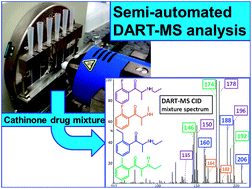Direct analysis in real time mass spectrometry (DART-MS) of “bath salt” cathinonedrug mixtures
Abstract
Rapid and versatile

* Corresponding authors
a
Department of Chemistry, University at Albany, State University of New York (SUNY), 1400 Washington Ave., Albany, NY 12222, USA
E-mail:
jshepard@albany.edu
b JEOL USA, Inc., 11 Dearborn Rd, Peabody, MA 01960, USA
c Mass Spectrometry Center, Merkert Chemistry Center, Boston College, 2609 Beacon Street, Chestnut Hill, MA 02467-3808, USA
Rapid and versatile

 Please wait while we load your content...
Something went wrong. Try again?
Please wait while we load your content...
Something went wrong. Try again?
A. D. Lesiak, R. A. Musah, R. B. Cody, M. A. Domin, A. J. Dane and J. R. E. Shepard, Analyst, 2013, 138, 3424 DOI: 10.1039/C3AN00360D
To request permission to reproduce material from this article, please go to the Copyright Clearance Center request page.
If you are an author contributing to an RSC publication, you do not need to request permission provided correct acknowledgement is given.
If you are the author of this article, you do not need to request permission to reproduce figures and diagrams provided correct acknowledgement is given. If you want to reproduce the whole article in a third-party publication (excluding your thesis/dissertation for which permission is not required) please go to the Copyright Clearance Center request page.
Read more about how to correctly acknowledge RSC content.
 Fetching data from CrossRef.
Fetching data from CrossRef.
This may take some time to load.
Loading related content
